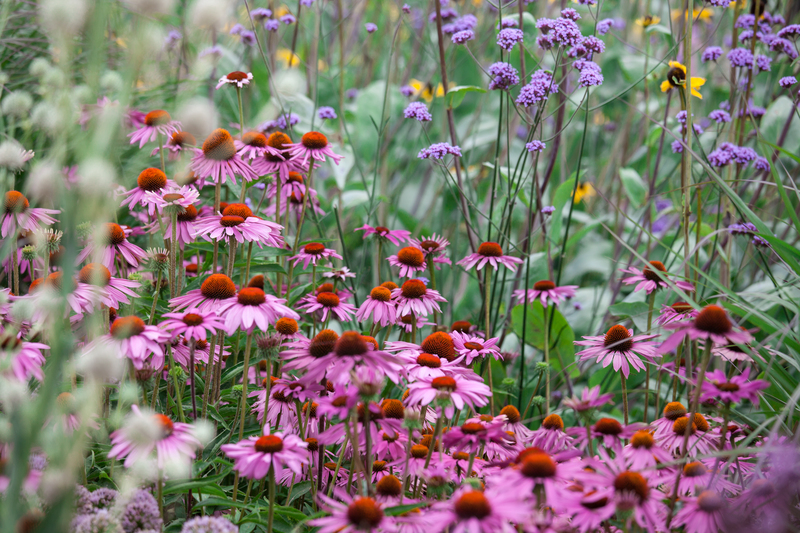Vertical Gardens: A Green Revolution
Posted on 19/06/2025
Vertical Gardens: A Green Revolution
In the heart of bustling cities and modern living spaces, lush greenery is often scarce. However, the innovative concept of vertical gardens is transforming urban landscapes and homes, ushering in what many call a green revolution. This comprehensive article explores the rise, benefits, types, and future of vertical gardens, offering invaluable insights for homeowners, businesses, and sustainability enthusiasts.

What Are Vertical Gardens?
Vertical gardens, also known as living walls, green walls, or vertical green spaces, are structures that allow plants to grow vertically, either attached to existing walls or as standalone installations. Unlike traditional horizontal gardens, vertical gardens maximize space by elevating foliage and flowers, making them perfect for both urban environments and areas with limited ground space.
- Living walls: These are panels of plants grown vertically using hydroponics or soil, most often attached to walls.
- Green facades: Involve climbing plants rooted in the ground or in containers who ascend via supports and trellises.
- Modular vertical planters: Flexible units that facilitate intricate designs and easy maintenance.
The Evolution of Vertical Green Spaces
The concept of gardening upwards is not entirely new. Hanging gardens date back to ancient civilizations, such as Babylon's famed wonder. However, contemporary vertical gardening technology adds new capabilities, using advanced irrigation, nutrients, and sustainable design. Today, architects, urban planners, and homeowners view vertical gardens as powerful tools to combat city pollution, improve well-being, and beautify surroundings.
Why Are Vertical Gardens Gaining Popularity?
Vertical gardens are not only visually striking but also incredibly practical. Cities like Singapore and Paris have embraced the trend, incorporating living walls into skyscrapers and commercial spaces, while homeowners supplement small balconies and indoor spaces with vertical planters. Here's why they're so popular:
- Space Savings: Vertical gardens allow for flourishing plant life even in limited areas, making greenery accessible to apartment dwellers and urbanites.
- Environmental Benefits: They contribute to improved air quality by absorbing carbon dioxide and pollutants, acting as natural urban lungs.
- Energy Efficiency: Green walls provide natural insulation, reducing temperature extremes and lowering energy costs.
- Boosting Biodiversity: These living features attract pollinators like birds, bees, and butterflies, enriching urban biodiversity.
- Psychological Uses: Studies reveal that proximity to greenery enhances mood and productivity, making vertical gardens popular in workplaces and classrooms.
Environmental Impact and Sustainability
Urban environments grapple with heat islands, pollution, and biodiversity loss--vertical gardens offer sustainable solutions:
- Air purification: Living walls trap dust, volatile organic compounds, and toxins, refreshing the air.
- Carbon sequestration: Plants absorb atmospheric carbon, playing a role in climate change mitigation.
- Water management: Innovative irrigation systems recycle water, making vertical garden maintenance eco-friendly.
- Energy reduction: Green walls shield buildings from direct sunlight, lowering cooling energy requirements.
Types of Vertical Gardens
1. Outdoor Vertical Gardens
Large-scale outdoor vertical gardens are often attached to building exteriors, courtyard walls, or as freestanding structures in parks and plazas. These can span several stories and use robust construction and automated irrigation.
2. Indoor Vertical Gardens
Indoor living walls are increasingly popular in homes, offices, hotels, and public spaces. These green installations improve indoor air quality, acoustics, and aesthetics.
3. DIY Vertical Gardens for Homeowners
Urban gardeners and hobbyists favor simple modular systems or upcycled vertical planters. Pallets, recycled bottles, and pocket planters create delightful home green walls on balconies or in kitchens.
- Frame Systems: Pre-designed frames for straightforward setup and maintenance.
- Pocket Planters: Felt or fabric pouches attached to walls, ideal for herbs and flowers.
- Trellises: Classic method for supporting climbing vines and creepers.
- Modular Tiles: Clip-on tiles filled with soil and plants for customizable designs.
Plant Selection for Vertical Gardens
Selecting the right plants for vertical gardens is crucial to long-term success. Consider light levels, water needs, and the garden's environment:
Best Plants for Vertical Green Walls
- Ferns: Hardy, low-maintenance, and lush green foliage.
- Pothos (Epipremnum aureum): Thrives indoors and purifies air.
- Succulents: Need minimal watering and add texture.
- Spider Plants: Excellent for removing toxins, easy to propagate.
- Herbs: Basil, mint, oregano, and parsley are perfect for kitchen green walls.
- Flowering plants: Begonias, petunias, and lobelias for color and vibrancy.
Edible Vertical Gardens
Vertical vegetable gardens are flourishing. Urban farms and home growers use vertical structures for lettuce, kale, strawberries, and even tomatoes, maximizing yield in tight spaces and enhancing food security.
Installation and Maintenance of Vertical Gardens
How to Install a Vertical Garden
Whether small balcony setups or expansive green facades, planning is the first step. Here's a simplified installation guide:
- Assess Space: Indoor or outdoor, sun exposure, weight limits, and available wall area.
- Choose System: Modular planters, hydroponic panels, or fabric pockets depending on size and budget.
- Watering: Automated drip irrigation or manual watering based on plant types and placement.
- Framework: Install waterproof membranes to protect walls and provide structural support.
- Plant Selection and Placement: Mix species for texture, color, and plant health.
- Lighting: Supplement with grow lights for indoor vertical gardens in low-light areas.
Vertical Garden Maintenance Tips
- Watering and feeding: Check regularly and ensure proper nutrition.
- Pruning: Keep plants tidy and encourage growth.
- Pest control: Watch for pests and use organic treatments where possible.
- System checks: Inspect irrigation and supports to avoid leaks or failures.
Vertical Gardens in Architecture and Urban Design
Cities around the world are reimagining urban landscapes by integrating vertical gardens into architecture. Examples include Singapore's "Gardens by the Bay," Milan's "Bosco Verticale," and the green facades of Paris.
- Green roofs and walls: Reduce urban heat islands and add natural beauty to skylines.
- Corporate adoption: Offices add living walls to improve employee well-being and optimize indoor climate.
- Public spaces: Parks, schools, and community centers are incorporating vertical gardens for educational and recreational benefits.
Case Study: Bosco Verticale, Milan
The "Bosco Verticale" (Vertical Forest) comprises two residential towers with over 900 trees and 20,000 plants. This project demonstrates how vertical gardening enhances biodiversity and reduces pollution even in the densest urban hubs.
The Benefits of Vertical Gardens
Environmental and Health Benefits
- Improved air quality: Natural plant filtration reduces pollutants indoors and outdoors.
- Reduced carbon footprint: Green walls act as carbon sinks and regulate temperature.
- Enriched biodiversity: Attracts beneficial insects, birds, and pollinators to urban spaces.
- Noise reduction: Dense plantings absorb sound, making spaces quieter.
- Mental health boost: Proximity to greenery reduces stress and fosters well-being.
Aesthetic and Social Advantages
- Visual appeal: Living walls transform dull spaces into vibrant, ever-changing works of art.
- Community engagement: Shared vertical gardens bring neighbors together and beautify neighborhoods.
- Increased property value: Green installations often increase real estate worth.
Challenges & Considerations
While vertical gardens offer many perks, there are challenges:
- Initial investment: Costs for professional installation can be significant, though DIY solutions are affordable.
- Maintenance requirements: Automated irrigation can fail, and some systems need regular attention.
- Plant selection: Not all species thrive vertically--research and planning are key.
- Structural limits: Not every building can support a heavy living wall, so reinforcement may be needed.

The Future of Vertical Gardens and Green Cities
As climate change and urbanization intensify, vertical gardens are poised to become crucial elements of sustainable city planning. Future trends include:
- Integration with Smart Technology: Automated systems monitor water, nutrients, and plant health for optimal maintenance.
- Community Living Walls: Shared vertical farms in residential buildings and neighborhoods.
- Green Infrastructure Expansion: More cities incentivizing green walls and roofs for new construction.
- Biophilic Design: Designing buildings and public spaces around the psychological need for natural elements.
Conclusion: Join the Green Revolution with Vertical Gardens
The rise of vertical gardens marks a vibrant shift towards sustainable, healthy, and visually enchanting environments. Whether you're an urban dweller, an entrepreneur, or a homeowner, integrating vertical green spaces brings you to the forefront of this green revolution. As technology advances and awareness grows, the possibilities for transforming our towns, homes, and lives with vertical gardens are truly limitless. Now is the perfect time to bring nature closer, one wall at a time.
Frequently Asked Questions about Vertical Gardens
-
Do vertical gardens require a lot of maintenance?
Not necessarily. Automated irrigation reduces manual work, but regular checks and pruning keep your living wall healthy. -
Can I install a vertical garden indoors?
Absolutely! With appropriate lighting and plant selection, indoor vertical green walls thrive. -
What are the best plants for vertical gardens?
Ferns, pothos, spider plants, succulents, and herbs are great choices for both hobbyists and experts. -
Are vertical gardens sustainable?
Yes, especially when designed with recycled materials, efficient watering, and native plants.
Ready to transform your environment? Start your vertical garden journey today and be part of the green revolution transforming cities and lifestyles worldwide!

